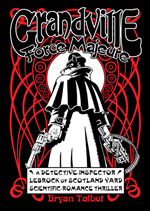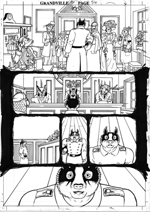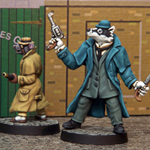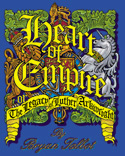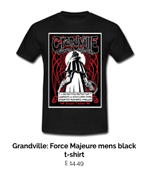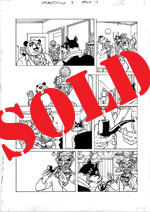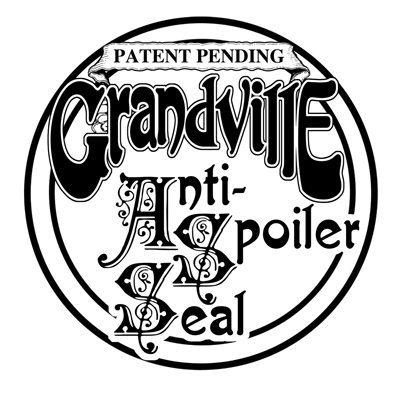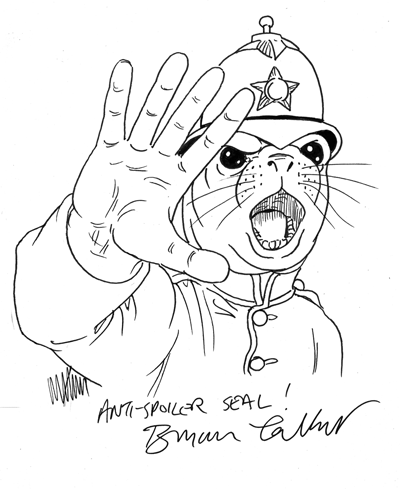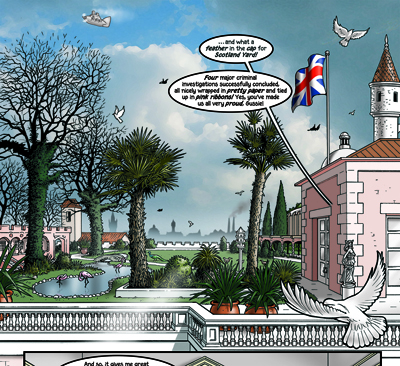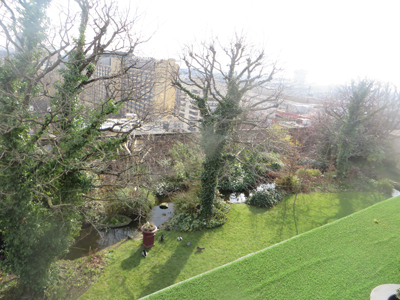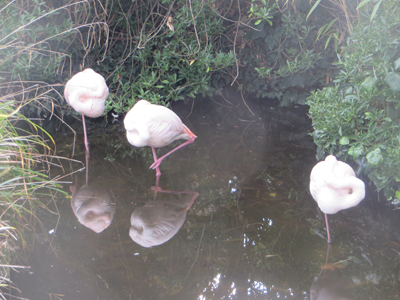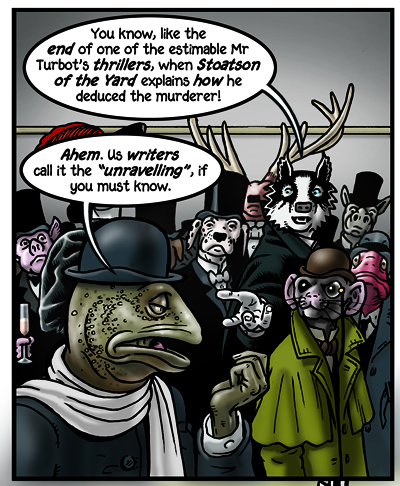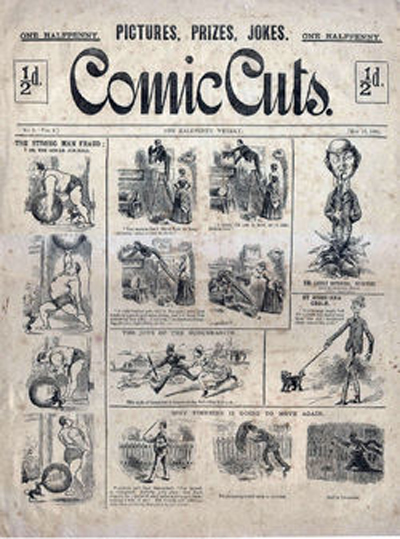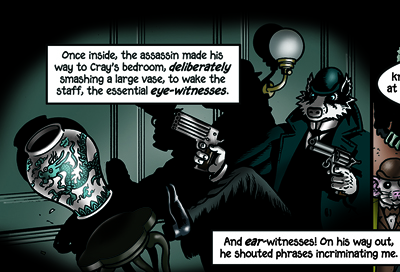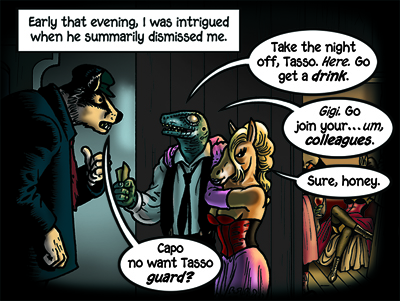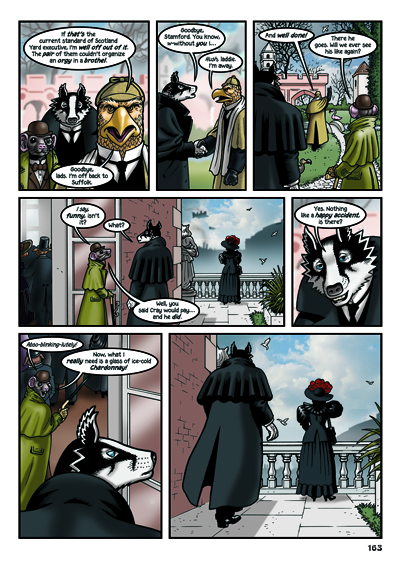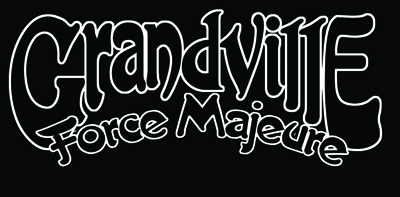
Grandville Force Majeure
annotations - batch 9
This is similar in concept to the Directors Cut of Heart of Empire that Bryan and myself created: it is an attempt to answer the eternal "where do you get your ideas from?" question, and a way to showcase the influences and images that went into the creation of Grandville.
We are publishing updates to this page every Sunday and we will cover the entire Grandville series: we have already completed the annotations for Grandville, Grandville Mon Amour, Grandville Bête Noire and Grandville Noël - and in case you missed them, check out the first batch of Grandville Force Majeure annotations.
And: this is the final batch of annotations for the final Grandville novel: it's been an absolutely pleasure to post these - but of course, all of the real work was done by Bryan, so here's a public and emphatic thank-you!
Start reading the Grandville Force Majeure annotations below, or jump straight to page 146, page 147, page 148, page 149, page 150, page 151, page 152, page 153, page 154, page 155, page 156, page 161, page 163, page 164, and page 166.
In the Jonathan Cape edition, the book had a removable plastic "Anti-spoiler seal" encasing the last 40 or so pages. I didn't want Tasso's secret and the fact that LeBock was still alive to be given away by accident. I think I must have invented this, as I know of no other example. Dark Horse wouldn't go along with it, claiming that retailers would complain that customers were tearing them off in the stores to see the end, thus spoiling the book. In the U.K., we never received a single complaint. In fact, most readers thought it was a very cool idea and it was mentioned in most of the reviews as a positive thing. It came complete with this label.
One reader emailed the website to joke that the anti-spoiler seal should have been an anthropomorphic seal, given the nature of the book, so I produced this quick cartoon in response, which James posted on the site.
Page 146
The location is a fantasy version of the real Kensington Roof Gardens, which really does have mature trees and flamingos. Actually, I’m not sure whether the flamingos are still there as, apparently, it closed to the public in February 2018. Before that, it was accessible to customers of the Babylon restaurant, situated on the top floor of the old Derry and Toms building in Kensington High Street. We went to have lunch there in February 2016, so I could take reference photos for this sequence, some of which are below.
The union flag seen here, and previously in the Grandville series, is the pre-Napoleonic version.
Page 147
Panel 3
“Hello, hello, hello. What’s all this then?”: a clichéd comedy phrase once attributed to bobbies.
Page 148
Panel 3
“…like the end of one of the estimable Mr Turbot’s thrillers when Stoatson of the Yard explains how he deduced the murderer.”: A once common ending to crime novels, in which the detective explains everything to assembled suspects, usually terminating in a revelation and the apprehension of the guilty party, such as in most of Agatha Christie’s Poirot stories.
“Ahem. Us writers call it “the unravelling”, if you must know.”: The type of ending just mentioned is known as a dénouement, from the French word meaning to untie or unravel (a noue meaning a knot). All characters in the Grandville books are supposed to be speaking in French and the reader is reading the translation.
Page 149
Panel 3
The Sherlock Holmes stories established the usage of disguises during the course of investigations, something much copied in subsequent detective stories by other writers. LeBrock establishes that he’s well aware of their use in Grandville Noël, page 50, panel 3, when we see that he’s transformed André Pegaus into a unicorn and says “ Disguise is an art form.” In the background, a vicar outfit is visible, a disguise used by Holmes in A Scandal in Bohemia.
Panel 5
This was staged while LeBrock and his family were visiting Roderick’s house on Xmas day in Noël.
Page 150
Panel 2
The English Channel is known in England, in the world of Grandville, as the French Channel, though the French word for it is La Manche.
Panel 3
This could have been set at many different locations along the Thames leading to London, but I chose Tilbury because of the resonance with Elizabeth I’s famous speech there before the expected invasion of the Spanish Armada in 1588.
Panel 6
Comic Cuts: The first British children’s comic, published from 1890 – 1953. It was so hugely popular and spawned so many imitators, it began the tradition of comics being regarded as a children’s medium. Up until then, they were solely produced for adult consumption, and usually satirical.
Page 151
Panel 8
“As quick as boiled asparagus”: according to the Roman historian Suetonius, this was a favourite expression of the Emperor Augustus (63BC – 14AD), and used extensively in one of my favourite all-time TV series I Claudius, based on the 2 novels by Robert Graves. We watch it on DVD about every 3 years.
Page 152
Panel 1
Described as “a Ming vase” on page 78, it is based on a real one from the Ming Dynasty.
Panel 4
As LeBrock mentions “bent coppers”, he casts a suspicious glance at our red herring.
Page 153
Panel 1
AAAAARGH! This caused me so caused me so much pain! After all the time I’d spent meticulously plotting the book, making absolutely certain that there were no plot holes, and polishing the dialogue dozens of times, this massive mistake sneaked through. The book, which had taken me about a year and a half to draw, was all completed and at the printers when, at the last conceivable minute, I received a set of proofs from Neil Bradford, Jonathan Cape’s head of book design. He told me that, if I wanted to change or correct something, this was my last chance to do it, as it was about to go to press. I was already pleased with the book, but decided to give the proofs one last read-through. Upon hitting this panel, which was perfectly fine, in story terms, it occurred to me that perhaps I could make it even clearer, and indicate the precise night when this panel took place. This is the original version.
I’d made a precise time-line of the order of events in the book to make sure that everything took place in the correct sequence. This panel was right. It worked. I should have left it alone. I didn’t. I changed it to make it obvious that it took place on the night of his supposed death, which it did. I quickly lettered it, straight into the text box, sent the file off to Neil and forgot about it. About a week later, while eating lunch, for some strange reason, it popped into my mind and I started to feel a sense of panic. After lunch, I ran downstairs to the studio and pulled up the file. I was shocked. I’d been concentrating so much on indicating the correct night, that I’d mistakenly typed in “…AFTER my apparent death” instead of “…BEFORE my apparent death”! This screws up the timeline. I immediately got in touch with Neil, but it was too late; it had already been printed. It was the curse of doing something in haste, under pressure. I felt physically ill for about a week afterwards, and it still makes me cringe when I think about it. I changed the panel back to how it had been and sent it to Neil, who replaced the offending page in their files. Thankfully, this means that the foreign editions and all future printings are now correct, but it doesn’t ease the pain!
Funnily enough, not a single reviewer picked up on it and I’ve never met anyone who noticed anything was wrong, even though the text says something occurred after we see it occurring sequentially two pages later and I’d publicly announced that the book contained a serious error, as reported on the Bleeding Cool site.
"Gigi": Gigi is a French nickname, usually reserved for women, whose names begin with "Gi" or "G", but also commonly used to abbreviate Virginie (Virginia) and Georgine. What most non-U.K. readers won't know is that "gee-gee" (similar to how Gigi is pronounced – a bit like "jeejee" ) is English slang for horse.
Panel 2
Bezique is a French card game, though I don’t imagine that “strip bezique” exists outside the world of Grandville.
“Frightening the horses”: this term, usually used humorously, originally comes from a comment made by the English stage actress Mrs Patrick Campbell (1865 - 1940) when asked about the suspected gay relationship of two of her friends, one of whom is said to have been Oscar Wilde:
“Does it really matter what these affectionate people do-- so long as they don't do it in the streets and frighten the horses!”
Panel 5 and panel 4, next page: I wonder if anyone noticed that there’s bamboo growing in the panda’s garden?
Page 154
Panel 7
“I should have been an actor, you know”: said by Holmes in reference to his mastery of character acting while in disguise. I can’t remember in which story.
Page 155
Panel 1
I planted the code described here by Roderick in pages 11 and 12 of Bête Noire.
Panel 3
A clear floor visible beneath a body is the clue that tells Holmes that the plaster busts were smashed after the murder in The Five Napoleons.
Panel 6
“Stool pigeon”: Why I made Walter a pigeon in the first place.
Page 156
Panel 1
“…the pneumatic interrossiter”: the interociter is a complex SF machine in the movie This Island Earth (1955).
Page 161
Panel 4
We first met the warden and saw the Tower of London maximum security prison back in Mon Amour.
Page 162
Panel 1
The suspicious red fish detective is revealed to be a Herring (see page 78, panel 1 annotations).
Page 163
The files for the completed pages sent to the publisher always have 2 Photoshop layers; a base layer for the art and a 2nd layer with the balloons and lettering on top. This is to make re-lettering easier for translated foreign editions. For some reason the lettering layer for this page had been moved up about a centimetre on the American (Dark Horse Books) edition, meaning that the balloons sometimes overlapped the top of the panels and the tails were misaligned. I have let them know and hope it’s fixed for future editions.
Panel 2
In this panel, I’m really saying that without Sherlock Holmes, whom Hawksmoor represents, LeBrock wouldn’t exist.
Panel 3
“Will we ever see his like again”:
“I shall not look upon his like again.”
Hamlet, Act 1, scene 2 William Shakespeare
Page 164
Panel 2
Seen here, in the background, and also in panel 6 on the next page is the Albert Hall, as seen from the Kensington Roof Gardens.
Panel 7
14th July: In the unlikely event that you don’t know, Bastille Day, (La Fête nationale or Le 14th Juillet, as it’s known in France) celebrates the storming of the Bastille in 1789, the turning point of the French Revolution.
Page 166
The 14th July firework displays around the Eiffel Tower really are as spectacular as this.
The end.

